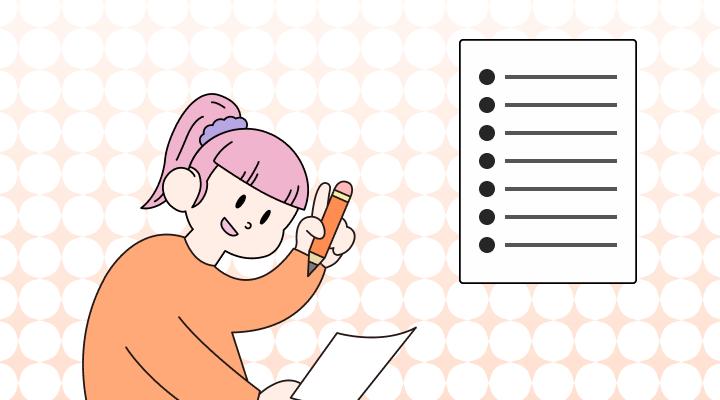Bullet Journaling, or BuJo, as it is affectionately called by its users and creator, is a new form of journaling, in which a diary can be a to-do list, a planner and a diary; it can contain a weekly spread, a monthly spread, or even a daily spread. These decisions are all up to you, your needs, and your creativity.
More information about Gratitude Journaling: The Power of Gratitude: How to Start and Keep a Gratitude Journal
In our fast-paced world, it's easy to feel overwhelmed by the constant flow of information, tasks, and responsibilities. This is where bullet journaling comes to the rescue. A bullet journal, or BuJo for short, is a versatile and highly customizable system that can help you bring order to the chaos of daily life.

In this blog post, we'll explore what bullet journaling is, why it's become so popular, and how to start your very own bullet journal.
Helpful tip:
Practicing reflective writing helps with anxiety, and also indirectly with academic performance. In a study conducted by Ashley Waggoner Denton, it was found that anxiety levels decreased, as more students completed the reflective journaling assignment. The study also suggested that the strong correlation between completing journals and achieving high exam scores couldn't solely be attributed to high-achieving students excelling in all areas, nor could it be solely explained by weaker students performing poorly in all aspects.
The numerous students' feedback regarding how journals aided them in time management, thought organization, and maintaining focus, showed that it was plausible that being a committed journal writer might have better equipped students to tackle final exam challenges. Thus, start journaling away to improve your learning abilities, and don't forget to use Engram to boost up your confidence one notch more in terms of English ability.
What Is Bullet Journaling?
A bullet journal is a combination of a to-do list, planner, and diary. It's a system that uses bullet points, short notes, and symbols to help you organize tasks, events, and thoughts in a simple and efficient way. The beauty of bullet journaling lies in its adaptability and flexibility – you create a journal that perfectly suits your needs.
Why Bullet Journaling?
- Customizable Organization: Unlike pre-designed planners, bullet journaling allows you to tailor your journal to your unique preferences and requirements.
- Increased Productivity: By breaking down tasks and goals into manageable chunks, you're more likely to stay on top of your to-do list and achieve your objectives.
- Mindfulness and Reflection: Bullet journaling can serve as a creative outlet, a place for reflection, and a way to track personal growth and accomplishments.
- Improved Time Management: With the help of monthly, weekly, and daily spreads, you can better manage your time, set priorities, and reduce stress.
How to Start Your Bullet Journal:
Get the Right Tools:
- A notebook: Any notebook will do, but many BuJo enthusiasts prefer dotted or grid notebooks, as they provide structure without being too restrictive.
- Writing tools: A set of pens in various colors for creative entries and highlighting.
Embrace Collections and Creativity:
- A collection in a bullet journal is just any entry in the journal.
- Four Core Collections: Key, Index, Future Log, Monthly Log, Weekly Spreads and the Daily Spreads.
- Collections can also be used to organize specific topics or projects. Examples include book lists, travel plans, or fitness trackers.
- Don't be afraid to get creative with doodles, hand lettering, and colors to make your journal visually appealing.
Create Key and Index Pages:
- Key Page: Start your bullet journal with a key page that explains the symbols you'll use (e.g., bullet points for tasks, circles for events, and dashes for notes).
- Index Page: Reserve the first few pages for an index. The index plays a pivotal role in structuring your Bullet Journal; it acts as the backbone of your journal's organization. It's where you record the locations of your various collections within your journal. Just create a list with the titles of your collections and their corresponding page numbers. Ensure that you number your journal pages if they are not already numbered.
Set Up Your Daily, Monthly and Future Log:
- The Monthly Log: The Monthly Log introduces a slightly more intricate structure to your bullet journal. It combines a calendar page and a task page. This calendar differs from the typical planner format we're accustomed to. To create it, number the days of the month along the left margin, accompanied by the initial letter of the corresponding day of the week. This calendar is designed for you to briefly document your tasks and events. Its simplicity eliminates clutter, allowing you to concentrate on the upcoming month. The task page serves as a repository for all significant, ongoing, or imminent tasks. Whether it's that looming presentation due in three weeks or a major party you need to prepare for, this is the place to offload those thoughts from your mind onto the page. The Monthly Log holds significance as it provides you with an opportunity to review and strategize how to tackle forthcoming tasks and events.
- The Future Log: The future log allows a little more freedom to format the way you want. List the upcoming months to give yourself a visual of what is yet to come. Some organize their future log with a preview of the full year, where others may do a six-month preview. This can help you get ahead and prevent tasks from sneaking up on you. List the name of the month followed by dates that have tasks or events. Be sure to look back on months as they go by to see if anything needs to be migrated into another log.
Design Your Weekly and Daily Spreads:
- Weekly spreads: Create weekly spreads (or weeklies) that outline your goals, tasks, events, and notes for the week ahead.
- Daily spreads: For daily spreads (or dailies), make a new entry each day, using a list format to track your tasks and activities.
Review and Reflect:
- Regularly review your journal to ensure you're staying on top of tasks and goals.
- Take time to reflect on your progress, personal growth, and what you've learned along the way.
Conclusion:
Bullet journaling is more than just a productivity tool; it's a personal journey of organization and self-discovery. It's a space to track your past, plan your future, and be present in the present. Whether you're a seasoned journaler or a beginner, the beauty of the bullet journal system is that it's entirely your own. So grab your notebook, pens, and creativity, and start your bullet journaling journey today. It's a powerful tool that can help you regain control of your life and turn your goals and dreams into reality.
Enlist Engram
You can enlist Engram to review your work so that you can submit it with confidence and ease!
Engram provides a proofreader and a paraphraser. With just a click of a button, transform your writing from good to a native speaker's level.

Reference

https://journals.sagepub.com/doi/full/10.1177/1475725717728676














